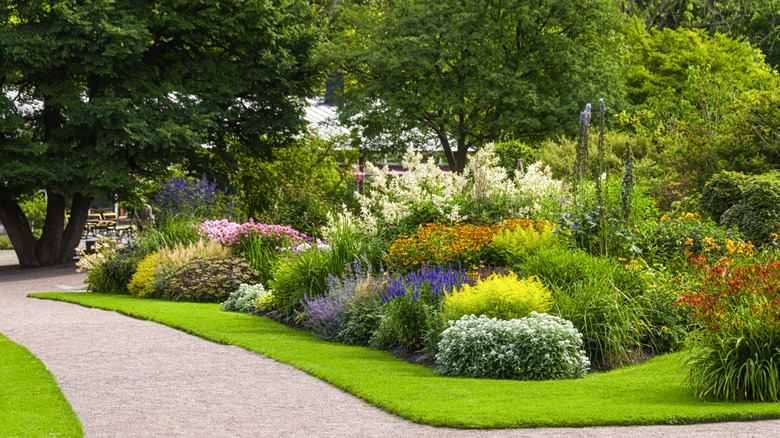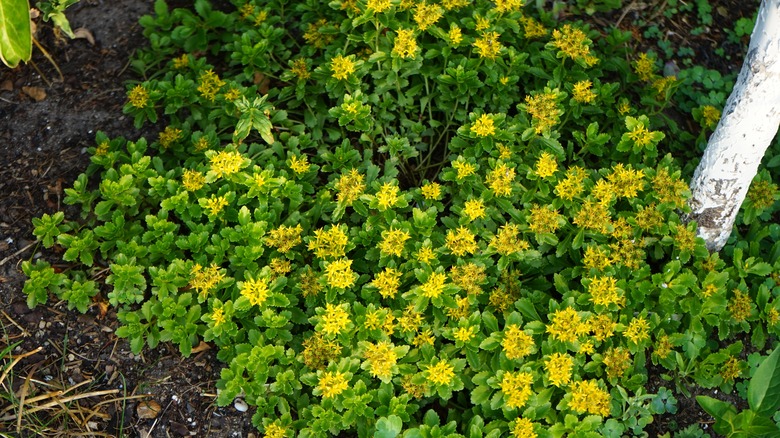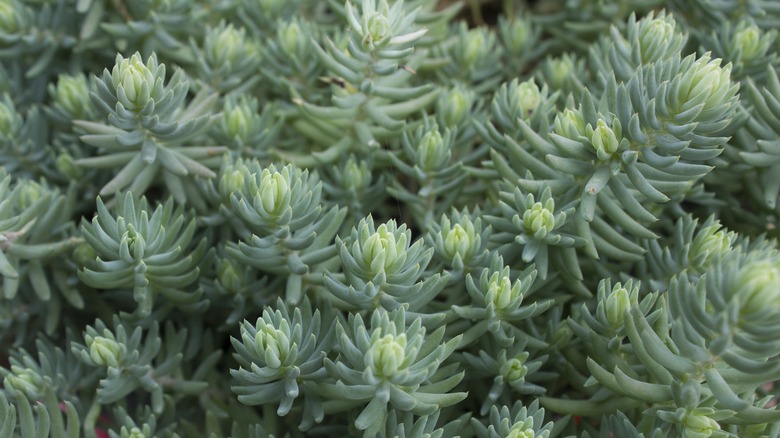The Perfect Ground Cover For Year Round Color In Your Garden
Grass may be the go-to ground cover in many places today, but that doesn't mean it will always be greener. If you live in a dry area and struggle to keep a lawn green, you'll likely see yellow or tan grass during summer. It often isn't an ecologically green choice either since it can require more than an inch of water each week, depending on the grass species and your climate. Sedum, or stonecrops, can be a great ground cover to grow instead of grass if you struggle to keep a green lawn in a hot, arid climate. The best part is that you can get more than just a green lawn if you go the sedum route since it comes in a variety of colors.
Sedum ground covers won't work for everyone, so you'll need to consider how your space is used and how much sunlight and water it typically receives. A sedum lawn won't survive beyond light usage. If you have pups or kiddos running around, the heavy foot traffic will make the leaves fall off, and the plants will eventually suffer too much. These plants also can't handle too much shade or water. If the space you want to cover is mostly shaded or prone to puddling, you likely won't be able to keep sedum plants happy.
Using sedum as a ground cover
Plants in the Sedum genus are called stonecrop succulents, aptly named for their ability to grow in rocky soils, often where other plants struggle. These succulents keep water in their leaves to survive through long periods of drought. Their leaves are often fleshy, though some species are flatter than others. Like the succulents you may be growing on your window sill, sedums don't require much water and crave plenty of sunshine, making them perfect for dry and sunny areas where you struggle to create a green lawn.
Sedums thrive in poor soils, so if your landscape has trouble spots with insufficient water and terrible soil, you can trust that sedums will happily claim them as their home. These plants love rocky or sandy soil that easily drains excess water away, though they can survive clay soils as long as they stay dry most of the time. Too much fertilizer will result in floppy growth, so you don't even have to worry about amending the soil unless it's truly destitute ground.
Choosing the right sedum variety
Sedums come in all shapes, sizes, and colors, so take some time to find the right kind for your situation. Some varieties can reach up to 3 feet tall and look beautiful in a flower bed. For lawns or flower beds you don't want growing too tall, look for the short varieties that only reach about 4 inches above the ground. Sedums will benefit your entire landscape by attracting pollinators with their small yet stunning flowers. If you grow flowers or vegetable gardens, look for the showiest sedum varieties you can find to bring in as many pollinators as possible.
Yellow stonecrop, Sedum nuttallianum, works well in a lawn setting since it stays close to the ground. It's tolerant of cold temperatures and forms clumps that are several feet wide. It has small yellow flowers in the spring and summer months. If you live in a warm climate with mild winters, Sedum mexicanum 'Lemon Coral' will work well. It has stunning lime-green foliage with summer flowers that look like stars. While many sedum varieties can't tolerate USDA zones above 9, this one can thrive in up to zone 11. There are over 300 species in the Sedum genus, so finding the right kind may take some work. Some can survive cold temperatures, while others can't handle extreme heat, so be sure to research which kind will work best in your climate.


